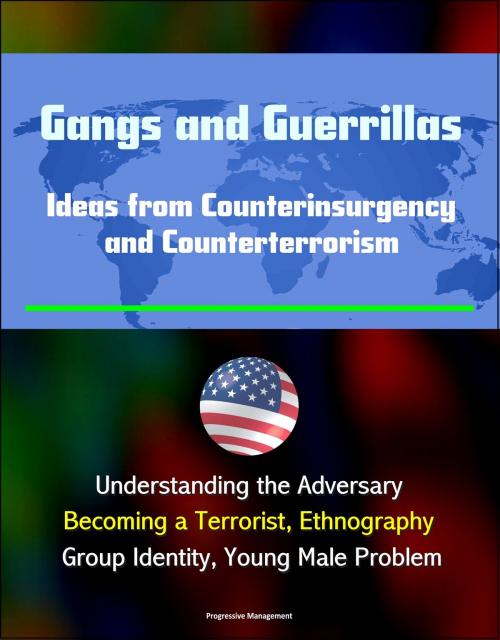Gangs and Guerrillas: Ideas from Counterinsurgency and Counterterrorism - Understanding the Adversary, Becoming a Terrorist, Ethnography, Group Identity, Young Male Problem
Nonfiction, Social & Cultural Studies, Social Science, Sociology, Urban, True Crime| Author: | Progressive Management | ISBN: | 9781310302923 |
| Publisher: | Progressive Management | Publication: | October 30, 2014 |
| Imprint: | Smashwords Edition | Language: | English |
| Author: | Progressive Management |
| ISBN: | 9781310302923 |
| Publisher: | Progressive Management |
| Publication: | October 30, 2014 |
| Imprint: | Smashwords Edition |
| Language: | English |
Can counter insurgency strategies be used to fight urban gangs? This question was discussed in a conversation between the Mayor of Salinas, the Provost of the Naval Postgraduate School and Representative Sam Farr. It became apparent during that discussion that there were many similarities between insurgent behavior and gang behavior—similarities that would make a more rigorous analysis worthwhile. These similarities are readily apparent when reading General Petraeus' counterinsurgency guidance for U.S. and NATO forces in Afghanistan. In his list of twenty-four "rules," many of them resonate, but especially the following: secure and serve the population; live among the people; help confront the culture of impunity; hold what we secure; foster lasting solutions; consult and build relationships, but not just with those who seek us out; walk; act as one team; be first with the truth; fight the information war aggressively; manage expectations; and live our values. Ultimately, these guidelines intend to reach the same end state as urban policing does: a safe and secure population.
With this theme in mind, the faculty of the Defense Analysis Department at the Naval Postgraduate School, experts in counterinsurgency operations, were enlisted to address these similarities and to share their theories, models, and ideas from their own disciplines of political science, sociology, anthropology, international relations, and more. This collection of short papers is the result.
The goal of this project is to share the ideas developed to fight insurgents and terrorists and see if they can be adapted or modified to help the people of Salinas think about their city's problem with gangs in an innovative way. Consequently, each chapter is intentionally left short, as they are intended to stimulate thought more than fully explain any one model or theory. The direct application of each chapter's concept is left to the reader.
Introduction * Conceptualizing the Problem * The Complete Win * Wicked Problems—Impossible to Solve and Difficult to Tame * Strategy * The Mystic Diamond: Applying the Diamond Model of Counterinsurgency in the Philippines * Rationality of Violence * Deterrence * Understanding the Adversary * Becoming a Terrorist: Psychological Processes * Leaving Terrorism: Disengagement and Deradicalization * Social Movement Theory * Understanding 'Culture' * What's Ethnography? * Group Identity * The Nature and Dissolution of Groups * Engaging Society to Counter Violent Groups * The Young Male Problem * Developing Strategy * Best Practices in Counterinsurgency * Military Decision-Making Process (MDMP) * Strategic Communication * Trust and Community Support * Population Control * Three Steps to Building and Operating Networks * Intelligence: Police, Counterinsurgency and Organized Crime * COMISAF'S Counterinsurgency Guidance * General David Petraeus
Can counter insurgency strategies be used to fight urban gangs? This question was discussed in a conversation between the Mayor of Salinas, the Provost of the Naval Postgraduate School and Representative Sam Farr. It became apparent during that discussion that there were many similarities between insurgent behavior and gang behavior—similarities that would make a more rigorous analysis worthwhile. These similarities are readily apparent when reading General Petraeus' counterinsurgency guidance for U.S. and NATO forces in Afghanistan. In his list of twenty-four "rules," many of them resonate, but especially the following: secure and serve the population; live among the people; help confront the culture of impunity; hold what we secure; foster lasting solutions; consult and build relationships, but not just with those who seek us out; walk; act as one team; be first with the truth; fight the information war aggressively; manage expectations; and live our values. Ultimately, these guidelines intend to reach the same end state as urban policing does: a safe and secure population.
With this theme in mind, the faculty of the Defense Analysis Department at the Naval Postgraduate School, experts in counterinsurgency operations, were enlisted to address these similarities and to share their theories, models, and ideas from their own disciplines of political science, sociology, anthropology, international relations, and more. This collection of short papers is the result.
The goal of this project is to share the ideas developed to fight insurgents and terrorists and see if they can be adapted or modified to help the people of Salinas think about their city's problem with gangs in an innovative way. Consequently, each chapter is intentionally left short, as they are intended to stimulate thought more than fully explain any one model or theory. The direct application of each chapter's concept is left to the reader.
Introduction * Conceptualizing the Problem * The Complete Win * Wicked Problems—Impossible to Solve and Difficult to Tame * Strategy * The Mystic Diamond: Applying the Diamond Model of Counterinsurgency in the Philippines * Rationality of Violence * Deterrence * Understanding the Adversary * Becoming a Terrorist: Psychological Processes * Leaving Terrorism: Disengagement and Deradicalization * Social Movement Theory * Understanding 'Culture' * What's Ethnography? * Group Identity * The Nature and Dissolution of Groups * Engaging Society to Counter Violent Groups * The Young Male Problem * Developing Strategy * Best Practices in Counterinsurgency * Military Decision-Making Process (MDMP) * Strategic Communication * Trust and Community Support * Population Control * Three Steps to Building and Operating Networks * Intelligence: Police, Counterinsurgency and Organized Crime * COMISAF'S Counterinsurgency Guidance * General David Petraeus















